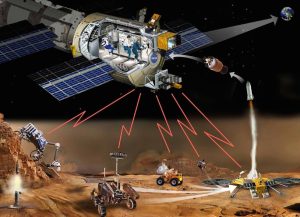
Space exploration has always captured our imaginations, promising adventures beyond our planet and insights into the universe’s mysteries. From the first steps on the Moon to the latest Mars rover missions, humanity has made remarkable strides. But what does the future hold for space exploration?
The Current State of Space Exploration
In recent years, we’ve seen incredible accomplishments, including the landing of NASA’s Perseverance rover on Mars and China’s Chang’e 5 mission returning lunar samples. These milestones highlight our growing capabilities and ambition.
Major Players in the Space Industry
NASA remains a leader, but other agencies like ESA (European Space Agency), Roscosmos, CNSA (China National Space Administration), and private companies like SpaceX and Blue Origin are playing increasingly prominent roles.
The Role of Technology in Space Exploration
Reusable rockets, pioneered by SpaceX’s Falcon 9, have drastically reduced the cost of space travel. This innovation paves the way for more frequent and sustainable missions.
Innovations in Spacecraft Design

Modern spacecraft are more durable and efficient, thanks to advancements in materials science and engineering. Concepts like NASA’s Orion and SpaceX’s Starship promise deeper space exploration.
The Importance of Artificial Intelligence
AI helps in mission planning, navigation, and data analysis, making missions more efficient and reducing human error. AI-driven rovers and satellites can conduct autonomous operations far from Earth.
The Moon: A Gateway to Further Exploration
The Apollo missions laid the groundwork for lunar exploration. Today, missions like Artemis aim to establish a sustainable human presence on the Moon.
Upcoming Lunar Missions
NASA’s Artemis program plans to land “the first woman and the next man” on the Moon by the mid-2020s, using it as a stepping stone for future Mars missions.
The Moon as a Launchpad for Mars
The Moon’s lower gravity makes it an ideal site for launching missions to Mars and beyond. Establishing a base there could facilitate deeper space exploration.
Mars: The Next Frontier
Mars, with its Earth-like features, has always fascinated us. It holds clues about the past presence of water and the potential for life.
Key Objectives of Mars Missions
Current and future missions aim to study Mars’ geology, climate, and potential for human habitation. The search for signs of past life remains a priority.
Challenges in Mars Exploration
Mars missions face numerous challenges, including harsh environmental conditions, long communication delays, and the technical difficulty of landing and operating on its surface.
Missions to Jupiter and Its Moons

Jupiter’s moons, like Europa and Ganymede, are prime targets for exploration due to their potential subsurface oceans. Missions like NASA’s Europa Clipper will investigate these worlds.
The Exploration of Saturn
Saturn’s moon Titan, with its thick atmosphere and liquid methane lakes, is a fascinating target. Future missions could explore its surface and study its potential for life.
Prospects for Uranus and Neptune
Missions to these distant ice giants are in the planning stages. They promise to reveal more about the outer reaches of our solar system and the formation of planets.
Importance of Studying Asteroids and Comets
These celestial bodies offer insights into the early solar system. They also contain valuable resources like water, metals, and organic compounds.
Upcoming Missions
NASA’s OSIRIS-REx mission, which sampled asteroid Bennu, is a significant step. Future missions will target other asteroids and comets for study and resource extraction.
Potential for Resource Extraction
Asteroids could provide materials for construction and fuel, supporting sustained space exploration and even potential space-based industries.
Joint Missions and Partnerships
International cooperation has led to significant achievements, such as the International Space Station (ISS). Joint missions allow for sharing of expertise, resources, and costs.
The Role of the International Space Station
The ISS serves as a hub for scientific research and international collaboration. It provides valuable experience for long-duration missions and living in space.
Future Collaborative Efforts
Upcoming projects, like the Lunar Gateway, a space station orbiting the Moon, highlight the importance of global partnerships in advancing space exploration.
Private Sector Involvement
Contributions of Companies like SpaceX and Blue Origin
Private companies are revolutionizing space travel. SpaceX’s advancements in reusable rockets and Blue Origin’s focus on space tourism are changing the landscape.
The Rise of Space Tourism

Space tourism is becoming a reality, with companies offering suborbital flights. This industry could fund further exploration and make space more accessible.
Commercial Opportunities in Space
The commercial sector sees potential in satellite deployment, asteroid mining, and even manufacturing in microgravity. These ventures could drive economic growth and innovation.
Sustainability in Space Exploration
Managing space debris is crucial for safe operations. Efforts include developing debris removal technologies and designing spacecraft to minimize debris creation.
Sustainable Practices in Space Missions
Using sustainable materials and practices ensures long-term viability. Reusable rockets and efficient resource management are steps toward sustainability.
The Role of Reusable Rockets
Reusable rockets reduce costs and environmental impact, making frequent missions more feasible. They are a cornerstone of future space exploration efforts.
Missions Focused on Finding Life
Missions like Mars rovers and Europa Clipper aim to find signs of life. Discovering even microbial life would be transformative.
Key Discoveries So Far
Evidence of water on Mars and complex organic molecules on Titan are significant. These findings fuel hopes of finding life elsewhere.
Future Plans and Possibilities
Upcoming missions will continue the search, focusing on environments like subsurface oceans on icy moons. The discovery of life would have profound implications.
Long-Duration Space Missions
Extended missions, such as those on the ISS, provide valuable data on the effects of long-term space living. These insights are crucial for future Mars and deep-space missions.
Challenges of Human Spaceflight
Radiation, microgravity, and psychological effects are major challenges. Developing solutions is essential for the health and safety of astronauts.
Future Plans for Human Settlements
Ambitious plans include lunar bases and Mars colonies. These endeavors will require significant advancements in technology and international cooperation.
The Role of Space Agencies
NASA aims to return humans to the Moon and eventually send crewed missions to Mars. Its Artemis program is a key part of this vision.
ESA’s Contributions

ESA’s missions to Mars, Jupiter, and its contributions to the ISS highlight its role in global space exploration efforts.
Emerging Space Agencies Worldwide
Countries like India and the UAE are making significant strides. Their contributions expand the reach and diversity of space exploration.
Technological Spin-offs
Space technology often finds applications on Earth, from medical devices to improved materials. These innovations benefit everyday life.
Educational and Inspirational Value
Space missions inspire future generations to pursue careers in STEM fields. They also foster a sense of global unity and curiosity.
Economic Benefits
Investments in space exploration drive economic growth, create jobs, and spur technological advancements. They have a significant return on investment.
Conclusion
The future of space exploration is bright and full of promise. Continued investment, technological innovation, and international collaboration will drive humanity’s journey to the stars. The exploration of space not only satisfies our curiosity but also brings tangible benefits to life on Earth. As we look to the future, the sky is not the limit—it’s just the beginning.










